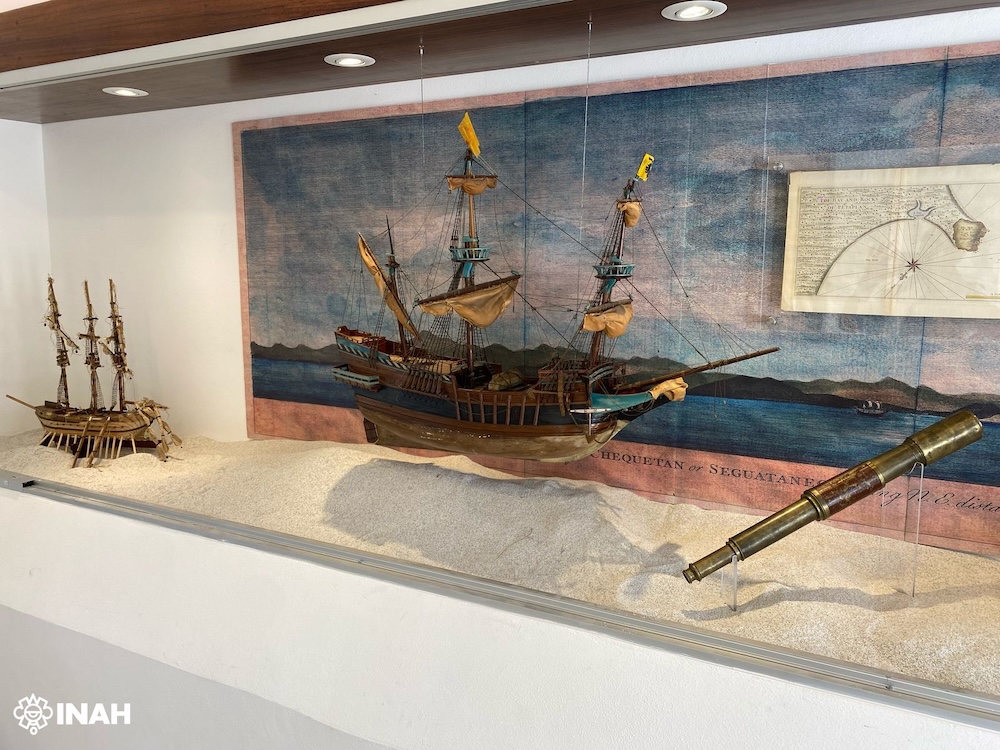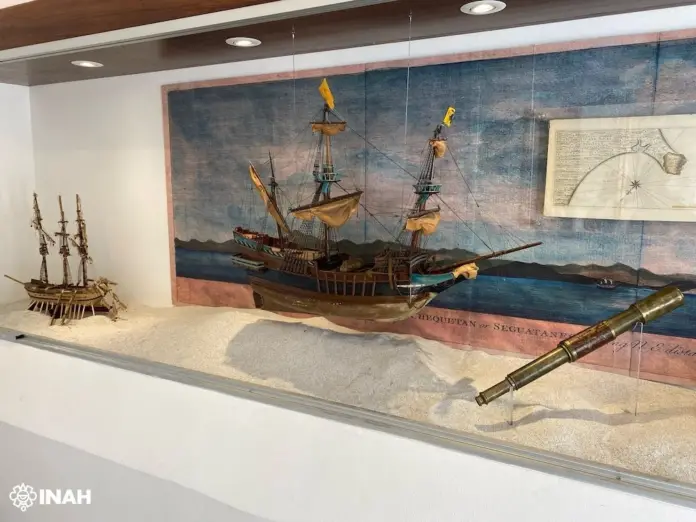Submerged in the crystal-clear waters of the rocky barrier of Las Gatas Beach in Zihuatanejo, Guerrero, lies an anchor that bears witness to one of the most daring acts of the famous English privateer George Anson (1697-1762). The story behind this episode is told in the renovated Archaeological Museum of the Costa Grande (MACOGRA), which, for the first time, incorporates the theme of piracy.
Located on the central Paseo del Pescador, the museum reopened a few weeks ago after architectural restoration work and an update to its museum design, carried out by the governments of the State of Guerrero and the City Council of Zihuatanejo de Azueta, with the special support of artist Carmen Parra and restorer Marisa Gómez Dantés.
The Mexican Ministry of Culture, through the National Institute of Anthropology and History (INAH), supported the development of the content. Both the research teams from the INAH Guerrero Center and the Subdirectorate of Underwater Archaeology (SAS), directed by Héctor Torres Calderón and Roberto Junco Sánchez, respectively, gave meaning to the sea of stories of the Costa Grande.
SAS historian Eduardo Cruz Soto, who collaborated on the project, comments that Room 4 was enriched for this purpose by addressing the region’s importance in the transpacific route of the Manila Galleon and, therefore, as a strategic point for assault and shelter from pirate incursions, primarily in the 17th and 18th centuries.
The work carried out by this agency in the area is also reported, such as geophysical surveys in Zihuatanejo Bay to characterize the seabed and locate ferrous materials associated with the archaeological context of three ships sunk by Anson in 1742: Nuestra Señora del Monte Carmelo, Nuestra Señora del Carmen, and El Aranzazú.
These three merchant ships, he says, had been captured by the privateer in late 1741; two of them in Valdivia, Chile, and another in the port of Paita, on the northern coast of Peru. His ambition was such that he headed to New Spain (Mexico) with the idea of seizing a Manila galleon bound for Acapulco.
However, the port’s defensive system intimidated him, and he diverted to Zihuatanejo. Due to the size of the convoy—which included his own ship, HMS Centurion—in March 1742, Anson decided to dismantle and burn the captured vessels. Their remains were left at the bottom of the bay, giving rise to the legend that the beaches of “de la Madera” and “de la Ropa” owe their names to the logs and cargo floating in the sea.
SAS research, explains its director, Roberto Junco, has revealed 11 sites with archaeological potential in Zihuatanejo Bay, several of them related to this historical event, in addition to the aforementioned admiralty-style anchor, extracted in the 1960s by diver Oliverio Maciel Díaz and later submerged at Las Gatas Beach for preservation.
The Macogra exhibits a cannon and a Peruvian jug—discovered by diver Gregorio Bustos Ayvar—potential witnesses to these events. A smaller-scale replica of the Oliverio anchor—the original measuring 3.70 m long by 2.20 m from tip to tip of its arms—based on photogrammetry performed by SAS specialist Gustavo García García. Also noteworthy are fragments of Chinese porcelain, which the same sub-directorate has located at the sites of El Bocotal and Río Chiquito, corroborating Zihuatanejo’s importance in New Spain’s maritime trade.
Archaeologist Junco, who earned his doctorate with a thesis dedicated specifically to “Admiral Anson’s lost ships in Zihuatanejo,” emphasizes that this figure is fascinating for his recklessness, which was a major disaster for the Spanish crown’s coffers and a miracle for the English crown:
“On June 20, 1743, he finally managed to capture a galleon southwest of the Philippines, the Nuestra Señora de Covadonga, which was laden with immense loot. Anson returned to England having circumnavigated the globe, a feat only accomplished by his compatriot, the pirate Francis Drake, in the 16th century. This is how he titled his memoirs, Voyage Round the World, which by the 18th century had become a bestseller.”
In Room 4 of the Macogra you can also see: a fragment of this book that describes the bay of Zihuatanejo and its surroundings, and an engraving from it, showing the confrontation between the HMS Centurion and the Nuestra Señora de Covadonga, off Cape Espíritu Santo – where the latter was captured -, as well as a portrait of the English admiral.
A Dolland London telescope and a model of the San Pedro—a scale replica of the ship on which Friar Andrés de Urdaneta traveled to the Philippines in 1564, made by Jesús Bracamontes Aviña and donated by Carmen Parra herself—are also part of the collection on display at the renovated Macogra (Paseo del Pescador s/n, Downtown Zihuatanejo, Gro.), which can be visited Tuesday through Sunday, from 10:00 a.m. to 6:00 p.m. General admission: 15 pesos.

Source: inah.gob




